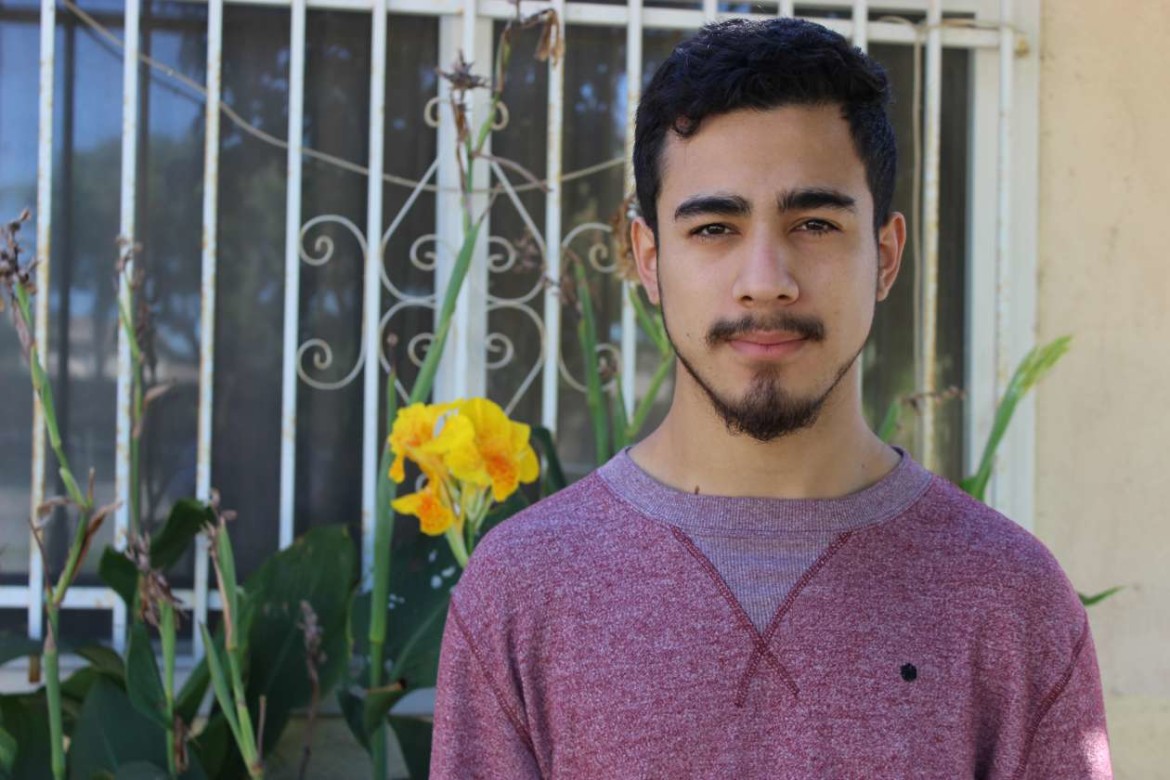
Susan Ferriss/Center for Public Integrity
Josue “Josh” Muniz, now 20, is suing the San Bernardino City Unified School District and a school police officer for excessive force and negligent training. The suit alleges that the officer grabbed Muniz, then 17, by the throat, pepper sprayed him and beat him before arresting Muniz for assault on the cop. Muniz says the officer was upset because he and girlfriend hugged after he ordered them to separate. The charge was dropped in court.
This story is from the Center for Public Integrity. It was reported in collaboration with The California Report, a production of KQED Public Radio.
SAN BERNARDINO, California — Josue “Josh” Muniz admits that he embraced his girlfriend during lunch, while the pair was out on the quad at Arroyo Valley High School in this city east of Los Angeles.
He admits that after a school cop ordered him to step away, he did, but lightly hugged his girlfriend again, minutes later, because she was upset.
But Muniz won’t agree that he deserved what happened next. His girlfriend walked off, and Muniz saw the officer approaching again and directing him to go with him. The cop reached out and “put his hand on my throat,” Muniz said. “That’s when I start freaking out. He tells me to stand up. And that’s when his grip on my throat got a little stronger and when I started really panicking.”
Alarmed, Muniz pushed at the officer to get him “just a little bit off me,” he said. They tumbled to the ground and the officer “showered” the student with pepper spray, Muniz alleges in a civil lawsuit that’s still pending. The cop handcuffed him, he said, dragged him into a nearby security office by the cuffs and planted a knee in between his shoulder blades while delivering “multiple blows” as Muniz lay face down on a carpet.
After it was over, the officer read the 17-year-old junior his rights and placed Muniz under arrest — for alleged misdemeanor assault on an officer.
“He told me that I had ‘f’d up,’ ” Muniz said. “But I never wanted to fight.”
In an initial substantive response in court, the school district claims that Muniz was “careless, reckless, and negligent,” and is the one to blame for any alleged injuries he suffered during the altercation.
Muniz’s arrest in November 2012 sounds extreme, but it was hardly isolated.
In fact, he was one of tens of thousands of juveniles arrested by school police in San Bernardino County over the last decade. The arrests were so numerous in this high-desert region known as the Inland Empire that they surpassed arrests of juveniles by municipal police in some of California’s biggest cities.
The San Bernardino City Unified School District, where Muniz was a student, has its own police department, with 28 sworn officers, eight support staff and more than 50 campus security officers trained in handcuffing and baton use.
The department made more than 30,000 arrests of minors between 2005 and 2014. The area has a reputation for youth-gang crime, but only about 9 percent of those arrests were for alleged felonies. Instead, the vast majority of arrests were for minors violating a variety of city ordinances — such as graffiti violations or daytime curfews — and for nearly 9,900 allegations of disturbing the peace. That’s a frequently-used catchall that raises questions among critics about whether most of these arrests were necessary for public safety.
The bulk of the minors arrested or referred to school police represent some of the most academically vulnerable demographics in the state: low-income Latino and black kids, as well as kids with disabilities, in disproportionate numbers, according to California arrest statistics and national education data examined by the Center for Public Integrity.
Based on 2011-2012 data collected from U.S. schools by the U.S. Department of Education, the latest available, Muniz’s Arroyo Valley High referred students to law enforcement at a rate of 65 for every 1,000 students. That was more than 10 times the national and California state rate of 6 per 1,000.
Those kinds of statistics raise red flags for critics who charge that school officers in some districts, especially those with substantial minority and special-needs populations, are turning what should be minor disciplinary indiscretions into criminal justice matters that put kids on a road to bigger problems — the so-called ‘school-to-prison pipeline.” In San Bernardino, cops, school officials, parents and community groups have started wrestling with how to balance demands for order — and security — without criminalizing kids.
There’s no state rule to define the role of school police, but some California districts have already taken steps to do that by imposing formal limits on police powers in school, and detailing what situations should require police involvement and what should be handled exclusively by educators.
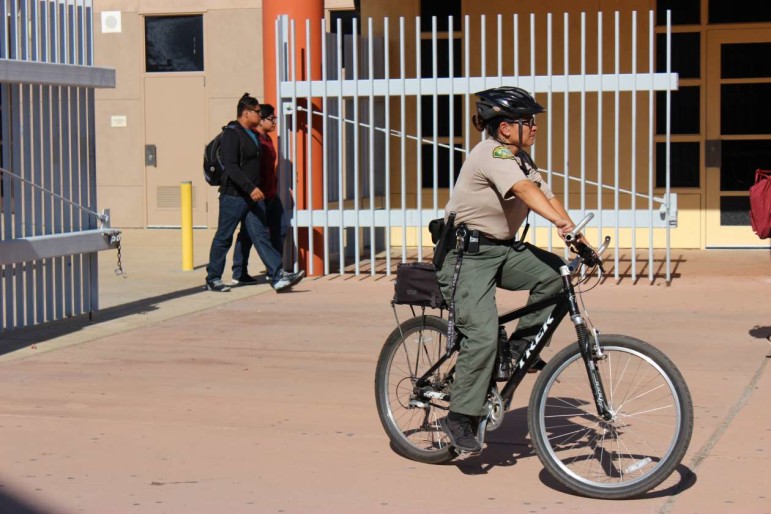
Susan Ferriss/Center for Public Integrity
San Bernardino City Unified School District police officers get support from more than 50 campus security officers who patrol campuses and are trained in handcuffing and baton use.
The roots of a trend
The ranks of school cops have grown nationally since the 1999 massacre of students and faculty at Columbine High School outside Denver. Some inner-city school districts have developed significant police agencies of their own and deployed them on campuses. The fear of terrorism and mass shootings like the rampage in San Bernardino this month all but guarantee that schools will continue to seek out ways to put police officers on campuses.
But teens and officers don’t always understand each other, and kids can pay a price when cops’ own conduct gets aggressive.
In October, students in South Carolina precipitated a federal civil-rights investigation with videos they surreptitiously shot of a school cop violently arresting a high school girl who’d been using her cell phone, tipping over her desk and dragging her across the floor.
Last April, in the San Bernardino city district, an 8th grader was allegedly ordered to remove clothing and unhook her bra and shake her breasts to see if she was hiding marijuana, according to her mother, Anita Wilson-Pringle.

San Bernardino City Unified School District mom Anita Wilson-Pringle wants answers following an allegation that her eighth-grade daughter was ordered to unhook her bra and shake her breasts as part of a marijuana search.
A female vice principal led the search, Wilson-Pringle said, which the district defended as a routine “pat down.” But Wilson-Pringle alleges that a male campus security officer who works for district police allegedly stood nearby. The district police chief denied that but was unwilling to release an internal review the chief said had been done — not even to Wilson-Pringle.
“I wonder how many other kids have been violated,” Wilson-Pringle said. State law prohibits strip searches by school employees.
Muniz’s lawsuit alleges that the San Bernardino city school district failed to properly train and supervise the officer who confronted him, Mark Clark. Clark coaches wrestling in the district and this past summer was promoted to sergeant.
In their defense, the district and Clark allege in court documents that Muniz “obstructed” a police officer, and that Muniz resisted arrest, causing Clark “to use only such force as was reasonably necessary … to overcome plaintiff’s resistance.”
Dennis Popka, lawyer for Clark and the district, declined to comment on the case while it’s pending.
Muniz, now 20, recalled his Mexican immigrant mother arriving at his school to find out how and why he’d been arrested and attempt to figure out what would happen next. Clark decided to write up his citation and release the boy to his mother pending his court date rather than put him in juvenile detention.
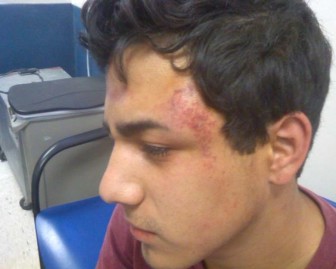
Courtesy of Josue Muniz
Josue “Josh” Muniz was left with bruises, scrapes and burns from pepper spray after a San Bernardino, California, school police officer subdued him following a dispute that started with Josue hugging his girlfriend at lunch.
Muniz’s mother signed papers in English she didn’t fully understand and burst into tears when she was allowed to see her son, and noticed his abrasions and swollen eyes.
“I explained to her that I was hugging my girlfriend,” Muniz said. “It didn’t make sense to her. How could a situation have escalated so quickly?”
Similar complaints of excessive school police intervention in other parts of the Golden State have pushed some prominent school districts to more narrowly define the role of school police on campuses and institute more oversight.
The Los Angeles and San Francisco school districts now have agreements forged in 2013 and 2014, respectively, defining discipline as the responsibility of educators, not police, and instituting limits on officer interrogations, arrests and tickets.
“Technically, a young person may commit a crime” by making threats, or getting into a physical fight, said Donna Groman, supervising judge of the delinquency division of Los Angeles County Juvenile Court. “It could be viewed as criminal conduct, but it might not be the type of conduct that really benefits a young person to be arrested and injected to the juvenile justice system.”
Police arrests should be selective — reserved for the most serious incidents — because any exposure to the juvenile justice system is harmful to minors, Groman said.
Groman arrived at her view from her experience as a judge. She also points to research finding that an arrest, a court appearance, and even brief detention, especially for minor infractions, actually increase a minor’s risk of dropping out and getting into more serious crime.
“Whether it stops with just an arrest or a citation,” she said, “that doesn’t matter. The harm has already been done and it’s difficult to undo that harm. It’s the beginning of a young person becoming disengaged from school, which is one thing you’re trying to avoid.”
School police agencies' arrests surpass city cop arrests over 10 years
California schools can contract with local police or form police forces. Ten years of arrest data show that two school police forces in San Bernardino County arrested more minors than municipal cops in their cities. Low-level misdemeanor accusations, especially disturbing the peace, dominate school police arrests in these districts of mostly Latino and black students. Status offenses are infractions that apply only to minors — like truancy or curfew violations.
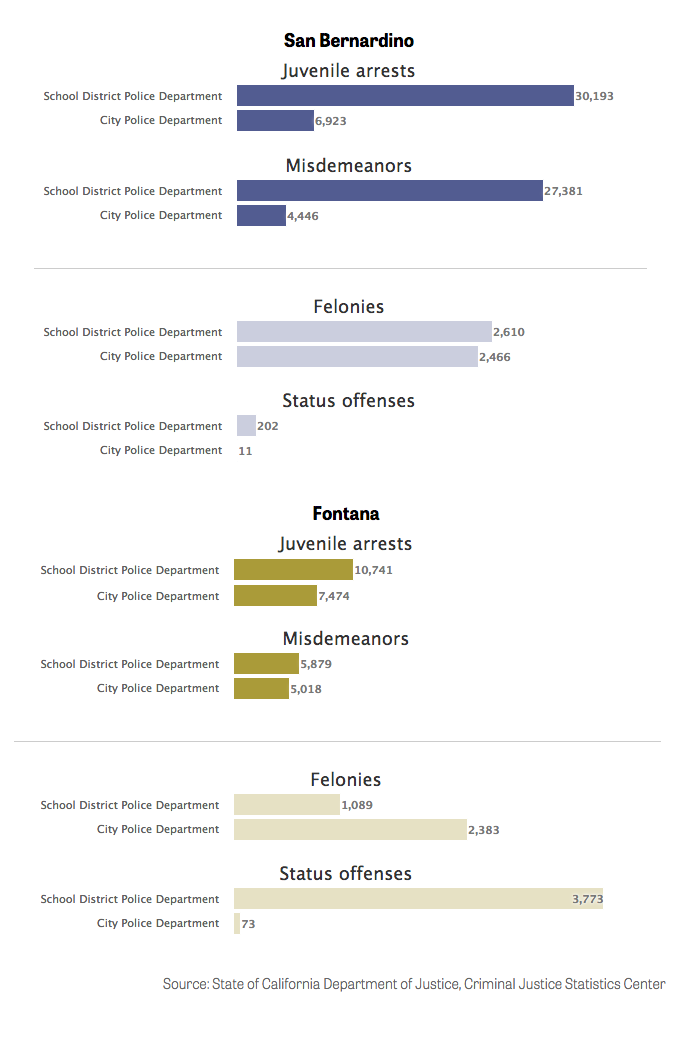
Alarming stats
In San Bernardino County overall, where political support for law enforcement traditionally runs strong, data show that 37 percent of minors funneled into the criminal justice system for misdemeanors were put there by just two school police departments — San Bernardino’s and the Fontana Unified School District police. San Bernardino is the largest county in the nation, encompassing over 20,000 square miles and containing more than 20 distinct cities, vast swaths of unincorporated areas and 2.1 million people.
Over the last 10 years, municipal cops in the city of San Bernardino have arrested just 6,923 minors in all, compared to the 30,000-plus arrests by school district police in the city. School cops do engage in enforcement off campus. But their primary turf is a district of about 54,000 students. City cops patrol a city of 215,000 residents.
The state data also detail how few arrests by school police were for felonies.
More than 27,000 of the 30,000-plus arrests of minors by San Bernardino school cops were for misdemeanor charges. About 36 percent of those were for disturbing the peace — a charge that can range from disruptive, loud behavior to physical fights.
The data show that the department’s arrests did decline, from 4,043 in 2005 to 1,078 last year.
But last year, based on state records, San Bernardino school cops still arrested more kids than municipal cops in Sacramento, Oakland or San Francisco. They even arrested more kids than police who patrol the nation’s second largest school district — Los Angeles Unified — which has a student body that’s more than 10 times larger than San Bernardino’s.
“That level of arrests is an alarm,” said attorney Ruth Cusick of Public Counsel, an L.A.-based pro bono law group that has collaborated with Groman on school police reforms. Those who think it’s natural for police in schools to arrest more kids than regular cops, she said, are denying the harm it does to kids and to relationships with police.
A steady stream of arrests, she said, “basically communicate[s] to students, ‘You’re not part of the community.’ ”
Some school cops' 2014 juvenile arrests rivaled or surpassed California big city police departments' arrests San Bernardino City Unified School District police arrested more minors in 2014 than Los Angeles Unified School District police — even though the L.A. district's enrollment is 10 times greater than San Bernardino's. Arrests by San Bernardino and some other school cops declined in recent years. But in 2014, some departments continued to rival or surpass the volume of juvenile arrests in many large cities — including San Francisco, Oakland and for some, Sacramento. 


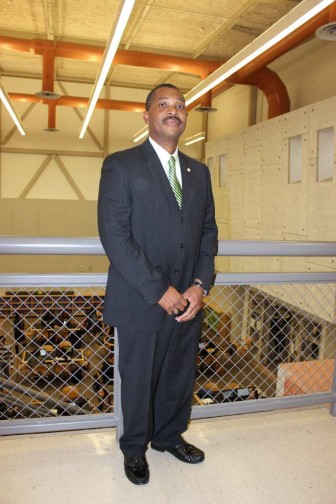
Susan Ferriss/Center for Public Integrity
San Bernardino City Unified School District Police Chief Joe Paulino stands in an atrium at the Arroyo Valley High School, where a former student who is suing the district was arrested in November 2012. Paulino said he’s now working to drive down his officers’ arrests of minors.
Changing the MO
San Bernardino school police Chief Joe Paulino agreed to meet at Arroyo Valley High, where Josue Muniz was arrested in 2012, to discuss the historically high volume of arrests — and reforms he agrees are needed and that he says are underway.
“I believe we’re emerging from that history,” Paulino said, “to this new place where we no longer believe that we have to attack these things [minor infractions] to be able to keep our youth safe. And we’re looking at it from not a zero tolerance to more of a tolerance to these behaviors.”
The district in November started talks to identify circumstances that don’t merit police intervention, Paulino said. Officers are already mindful to follow a new “matrix” calling for students to get an opportunity to correct misbehavior — like a first-time fight — before they face arrest.
Paulino also said officers are now handing out “positive tickets” and prizes to students identified as having done good deeds. The practice is part of a “different mindset,” he said, that police are developing.
There’s still a maxim posted on the department’s website that says the purpose of citations — the real ones that put kids into the justice system for alleged crimes — “is not to punish them but to help them change bad behavior patterns.”
“I don’t believe that anybody should be handcuffed because they’re kissing,” he said. “However, it if turns into where I request that you go to class and it becomes violent, then again, we as police officers have the right to be able to defend ourselves as well as others we believe may be injured by another’s action.”
Trouble in Fontana
Elsewhere in San Bernardino County, there are other signs of problematic school policing.
Officers with the 40,000-student Fontana Unified School District, not far from the city of San Bernardino, arrested 10,741 juveniles over the last decade, a volume that also surpassed the 7,474 arrests of minors by Fontana city police.
Fontana school cops run the Fontana Leadership Intervention Program, a counseling and boot-camp program for students identified at school or in court as “at-risk.” In 2012, an officer who coordinated the FLIP program, which took kids on trips to colleges and prisons, was fired because he had allegedly boasted of having sex with mothers of kids in the program, according to documents in lawsuits filed by school staff.
In the community of Chino, the case of a student with Down syndrome who was arrested at his high school exemplifies concerns at the legal-defense group Disability Rights California that special-needs kids are getting criminalized at school.
Krystine Roldan, the guardian and sister of the student with Down syndrome, was shocked when she received word that her brother Christian had been arrested in 2013 at Ayala High School in the Chino Valley Unified School District. He was charged with resisting a peace officer. Roldan said she found her 16-year-old brother “crumpled up” and hogtied, inside the back of a sheriff’s vehicle.
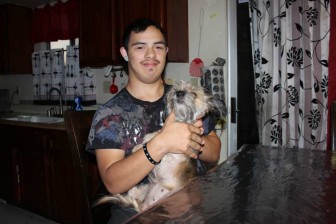
Susan Ferriss/Center for Public Integrity
Christian Roldan, 18, holds his dog DD at home in Chino, California. He has Down syndrome and can only respond to questions with one or two-word replies. He was hogtied and arrested in 2013 for resisting a school police officer’s attempts to search him at the Chino Valley Unified School District.
“His hands are behind his back and his feet are tied together with handcuffs and they’re connected and he’s sweating. He’s crying,” Roldan recalled. “I kept saying you guys have to let him go. He has breathing issues.” The deputies said Christian had made threats. Roldan pointed out that Christian can only respond to questions with one- or two-word answers.
Ayala’s school resource office — a county sheriff’s deputy on contract — wrote up a report about an incident that led to Christian’s arrest.
Christian left class to go to the bathroom, unsupervised, and was later found sitting in an outside area on two airsoft guns, replica firearms that shoot plastic pellets. Roldan said she doesn’t know where he got the airsoft guns. The school officer doesn’t speculate in her report. A teacher picked up the prohibited replica guns, and Christian walked with him to the police office.
The officer was told he had Down syndrome. She began questioning the teen about the guns. She wrote that he appeared agitated, “had his hands clenched in fists” and “would not cooperate with my commands.” She wanted to search him for any other weapons. He “mouthed” a profanity. She called for more deputies, and they “escorted him to the floor to gain control of his arms and body.”
Christian was restrained, searched and taken to a patrol vehicle. “No additional contraband was found on his person,” the resource officer wrote. Yet he was arrested.
After sitting in a jail cell with his sister, Christian was released to his sister that day, but out of school for months. Therapists said it was too traumatic for him to return to the school, but the district said it couldn’t find another suitable placement for him, until after Roldan contacted Disability Rights for help, she said. She also had to take Christian to juvenile court two times to answer to his criminal charge before a judge was satisfied he had Downs Syndrome and dismissed the case.
“I thought they were there to protect him,” Roldan said of educators and police. He’s still terrified of police, she said, and she’s worried he won’t ask for help when he needs it.
National data show that the Chino Valley district referred students to law enforcement at rate of 21 for every 1,000 pupils during the 2011-2012 year — more than three times the national rate of 6 per 1,000. Disabled students were referred at a rate of 61 students per 1,000 kids, compared to a national rate of 14 per 1,000.
California's overall rate of about 6 per 1,000 students was equal to the national overall average. 
Chino Valley schools’ risk and safety manager Dan Mellon spoke for the district.
Confidentiality laws, he said, bar him from addressing Christian’s arrest. But he explained that the district contracts with local police agencies for school resource officers and those officers decide if a student should be arrested in connection with incident.
“We’re not going to interfere with a sworn officer’s duties,” he said. And if the school didn’t file a charge, administrators have no influence to get it dropped, he said.
In the San Bernardino district, Ray Culberson, director of the Youth Services program, is trying to ensure that changes occur in both disciplinary procedures and decisions to arrest kids. He grew up in tough circumstances here and feels that kids got more breaks back then than they do now.
Culberson is pushing for school leaders, campus by campus, to institute “restorative justice” circles, where students and staff air grievances about incidents and amends can be made.
With the backing of the district attorney’s office in San Bernardino County, he also recently started an informal district “youth court” that he’s urging both principals and police to make use of; they can send kids to this mock court rather than expelling them or sending them into real court. Juries of peers will try kids — if they admit to misconduct — and impose consequences such as an essay of apology, a visit to a hospital or a ride with police on patrol. If they fail, then they face the official system.
In October, a homeless boy, 13, facing possible expulsion, was tried for bringing a lighter to school and smoking cigarettes. He was told to write an essay, among other amends.
Culberson said he knows not everyone in the district is sold on reforms that include having to train in new ways to resolve conflict, like restorative justice, which take time that teachers often say they don’t have. Adults habitually say they want to do “what’s in the best interest of kids,” he said. “Do we do that? We don’t do that with 100 percent fidelity.”

Susan Ferriss/Center for Public Integrity
Ray Culberson, director of Youth Services for the San Bernardino City Unified School District, says he want to persuade principals to move away from expulsions and arrests by using counseling and conflict-resolution methods.
At a downtown San Bernardino County office, juvenile probation officers, some of whom are also posted right on campuses, said they approve of a lot of the new ideas. They also said they think schools have already been working hard to get students plenty of support before they end up arrested.
Kids arrested on first-time misdemeanors in this county can go to court if they want to contest a charge. But if they admit to a charge, they can get a “diversion” to probation officers, a less formal procedure, and receive referrals for counseling — as well as consequences for what they did, such as mandatory community service.
Officer Maria Barton said school cops care, and frequently consult with her before making an arrest. But there are times, she said, when cops have to “deal with the instant moment,” and may have to subdue and arrest kids — and ask questions later.
But does she think a school cop should intervene if kids are hugging, as Officer Clark allegedly did when he saw Muniz and his girlfriend? At most, that’s a violation of school rules.
“Absolutely,” Barton said. “Any adult who works on a school campus is entitled to anything that deals with those kids. If it’s a custodian, an administrator, a teacher, a clerk, a probation officer, a police officer, when we see something inappropriate it should be addressed.”
There’s quite a bit of inappropriate hugging on campuses, Barton said, and parents want to know that officers are keeping their kids safe.
But did the officer go too far?
Kimberly Epps, another probation officer, said it’s difficult to judge without knowing the details. All adults on campus have to watch out for sexual harassment, she said. And she advises juveniles that when a cop gives you orders the best course of action is “to cooperate in the situation and do what’s being asked of you — and it doesn’t go, perhaps, where it doesn’t need to go.”
Ironically, Muniz said, the day he was arrested he was trying to stay safe. He was sitting in the vicinity of Officer Clark’s office because some “gangster” kids had been picking on him and his mother wanted him to stay close to security while out on the quad.
He’d never been in trouble with police, he said, and he was startled at how angry Clark allegedly appeared to be when he came over after the second hug.
“It was actually a pretty big event in my life,” Muniz said of the arrest. “I think if it weren’t for that, a lot of things would be different right now.”
Because of the seriousness of the charge, Muniz said, a vice principal he got along well with had no choice but to recommend he be expelled. But at the school-based hearing, Muniz said, “his face was showing regret more than anything else.” Officer Clark spoke out against Muniz at the hearing, identifying him as the aggressor, and to Muniz appeared “the only one determined to win” the recommendation to expel him.
Ultimately, Muniz prevailed, and the school expulsion panel decided not to eject him from the district. It helped, he said, that his girlfriend had quickly used Google while he was in custody at school, and found him a lawyer. When he went to court later, he said, the fact that he was spared from expulsion seemed to help. Prosecutors decided not to pursue the case and the charge was dropped.
By that time, though, he felt he’d been stigmatized.
He’d missed a lot of class time. He’d been forced to transfer to a special campus for troubled kids that he didn’t like. He and the girlfriend drifted apart. He ended up dropping out, his confidence shaken. He regrets it now, but at the time it seemed like nobody cared. He wants to pursue a GED diploma, but time is limited, as he needs to work and is constantly scrambling to get temporary jobs at warehouses here that are big employers.
But Muniz also said he lost something else with his arrest. Not long before, he was at church with his mother and conversed with a police officer about his career. He began dreaming of becoming a cop. But he says now that he couldn’t stand by and “keep my mouth shut” if he saw a fellow cop abusing people.
He decided to pursue his lawsuit, which is slowly moving along with pre-trial motions, because he felt that Officer Clark thought he was “basically, nobody.” The legal challenge, he said, has helped him feel that’s not true.
“It’s like the only way” he said, “that I feel like I have some sort of power.”
This story was written by the Center for Public Integrity. Amy Isackson of KQED public radio’s “The California Report” helped prepare this investigation in collaboration with the center and produced a companion radio report.